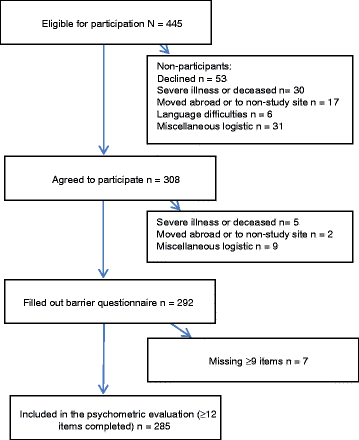Development and psychometric testing of a barriers to HIV testing scale among individuals with HIV infection in Sweden; The Barriers to HIV testing scale-Karolinska version
- PMID: 26584977
- PMCID: PMC4653894
- DOI: 10.1186/s12955-015-0381-7
Development and psychometric testing of a barriers to HIV testing scale among individuals with HIV infection in Sweden; The Barriers to HIV testing scale-Karolinska version
Abstract
Background: Barriers to HIV testing experienced by individuals at risk for HIV can result in treatment delay and further transmission of the disease. Instruments to systematically measure barriers are scarce, but could contribute to improved strategies for HIV testing. Aims of this study were to develop and test a barriers to HIV testing scale in a Swedish context.
Methods: An 18-item scale was developed, based on an existing scale with addition of six new items related to fear of the disease or negative consequences of being diagnosed as HIV-infected. Items were phrased as statements about potential barriers with a three-point response format representing not important, somewhat important, and very important. The scale was evaluated regarding missing values, floor and ceiling effects, exploratory factor analysis, and internal consistencies.
Results: The questionnaire was completed by 292 adults recently diagnosed with HIV infection, of whom 7 were excluded (≥9 items missing) and 285 were included (≥12 items completed) in the analyses. The participants were 18-70 years old (mean 40.5, SD 11.5), 39 % were females and 77 % born outside Sweden. Routes of transmission were heterosexual transmission 63 %, male to male sex 20 %, intravenous drug use 5 %, blood product/transfusion 2 %, and unknown 9 %. All scale items had <3 % missing values. The data was feasible for factor analysis (KMO = 0.92) and a four-factor solution was chosen, based on level of explained common variance (58.64 %) and interpretability of factor structure. The factors were interpreted as; personal consequences, structural barriers, social and economic security, and confidentiality. Ratings on the minimum level (suggested barrier not important) were common, resulting in substantial floor effects on the scales. The scales were internally consistent (Cronbach's α 0.78-0.91).
Conclusions: This study gives preliminary evidence of the scale being feasible, reliable and valid to identify different types of barriers to HIV testing.
Figures
Similar articles
-
COVID-19-related stigma among infected people in Sweden; psychometric properties and levels of stigma in two cohorts as measured by a COVID-19 stigma scale.PLoS One. 2023 Jun 21;18(6):e0287341. doi: 10.1371/journal.pone.0287341. eCollection 2023. PLoS One. 2023. PMID: 37343027 Free PMC article.
-
Development of a 12-item short version of the HIV stigma scale.Health Qual Life Outcomes. 2017 May 30;15(1):115. doi: 10.1186/s12955-017-0691-z. Health Qual Life Outcomes. 2017. PMID: 28558805 Free PMC article.
-
Psychometric evaluation of the HIV stigma scale in a Swedish context.PLoS One. 2014 Dec 18;9(12):e114867. doi: 10.1371/journal.pone.0114867. eCollection 2014. PLoS One. 2014. PMID: 25522127 Free PMC article.
-
Adaption and validation of the adherence barriers questionnaire for HIV patients on antiretroviral therapy (ABQ-HIV).BMC Infect Dis. 2018 Nov 28;18(1):599. doi: 10.1186/s12879-018-3530-x. BMC Infect Dis. 2018. PMID: 30486795 Free PMC article.
-
Psychometric properties of a short version of the HIV stigma scale, adapted for children with HIV infection.Health Qual Life Outcomes. 2013 Nov 14;11:195. doi: 10.1186/1477-7525-11-195. Health Qual Life Outcomes. 2013. PMID: 24225077 Free PMC article.
Cited by
-
Health beliefs and barriers related to HIV prevention and screening among students of the University of Vlora: a cross-sectional study.BMC Public Health. 2020 Aug 27;20(1):1302. doi: 10.1186/s12889-020-09416-8. BMC Public Health. 2020. PMID: 32854674 Free PMC article.
-
Measuring barriers to fistula care: investigating composite measures for targeted fistula programming in Nigeria and Uganda.BMC Womens Health. 2021 Apr 7;21(1):142. doi: 10.1186/s12905-021-01288-3. BMC Womens Health. 2021. PMID: 33827536 Free PMC article.
-
Cohort profile: InfCareHIV, a prospective registry-based cohort study of people with diagnosed HIV in Sweden.BMJ Open. 2023 Mar 17;13(3):e069688. doi: 10.1136/bmjopen-2022-069688. BMJ Open. 2023. PMID: 36931676 Free PMC article.
-
Assessment of an instrument scale measuring the knowledge of antiretroviral therapy among people living with HIV.BMC Public Health. 2023 Feb 7;23(1):278. doi: 10.1186/s12889-023-15220-x. BMC Public Health. 2023. PMID: 36750811 Free PMC article.
References
-
- WHO. Data on the size of the HIV/AIDS epidemic: data by WHO region. 2014. http://apps.who.int/gho/data/view.main.22100WHO?lang=en. Accessed 7 May 2014
-
- Lewden C, Chene G, Morlat P, Raffi F, Dupon M, Dellamonica P, et al. HIV-infected adults with a CD4 cell count greater than 500 cells/mm3 on long-term combination antiretroviral therapy reach same mortality rates as the general population. J Acquir Immune Defic Syndr. 2007;46:72–77. doi: 10.1097/QAI.0b013e3181576818. - DOI - PubMed
Publication types
MeSH terms
LinkOut - more resources
Full Text Sources
Other Literature Sources
Medical


